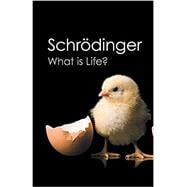
Note: Supplemental materials are not guaranteed with Rental or Used book purchases.
Purchase Benefits
What is included with this book?
| What is Life? | |
| Preface | p. 1 |
| The Classical Physicist's Approach to the Subject | p. 3 |
| The general character and the purpose of the investigation | |
| Statistical physics. The fundamental difference in structure | |
| The naive physicist's approach to the subject | |
| Why are the atoms so small? | |
| The working of an organism requires exact physical laws | |
| Physical laws rest on atomic statistics and are therefore only approximate | |
| Their precision is based on the large number of atoms intervening, 1st example (paramagnetism) | |
| 2nd example (Brownian movement, diffusion) | |
| 3rd example (limits of accuracy of measuring) | |
| The √n rule | |
| The Hereditary Mechanism | p. 19 |
| The classical physicist's expectation, far from being trivial, is wrong | |
| The hereditary code-script (chromosomes) | |
| Growth of the body by cell division (mitosis) | |
| In mitosis every chromosome is duplicated | |
| Reductive division (meiosis) and fertilization (syngamy) | |
| Haploid individuals | |
| The outstanding relevance of the reductive division | |
| Crossing-over. Location of properties | |
| Maximum size of a gene | |
| Small numbers | |
| Permanence | |
| Mutations | p. 32 |
| 'Jump-like' mutations - the working-ground of natural selection | |
| They breed true, i.e. they are perfectly inherited | |
| Localization. Recessivity and Dominance | |
| Introducing some technical language | |
| The harmful effect of close-breeding | |
| General and historical remarks | |
| The necessity of mutation being a rare event | |
| Mutations induced by X-rays | |
| First law. Mutation is a single event | |
| Second law. Localization of the event | |
| The Quantum | |
| Mechanical Evidence | p. 46 |
| Permanence unexplainable by classical physics | |
| Explicable by quantum theory | |
| Quantum theory - discrete states -quantum jumps | |
| Molecules | |
| Their stability dependent on temperature | |
| Mathematical interlude | |
| First amendment | |
| Second amendment | |
| Delbrück's Model Discussed and Tested | p. 56 |
| The general picture of the hereditary substance | |
| The uniqueness of the picture | |
| Some traditional misconceptions | |
| Different 'states' of matter | |
| The distinction that really matters | |
| The aperiodic solid | |
| The variety of contents compressed in the miniature code | |
| Comparison with facts: degree of stability; discontinuity of mutations | |
| Stability of naturally selected genes | |
| The sometimes lower stability of mutants | |
| Temperature influences unstable genes less than stable ones | |
| How X-rays produce mutation | |
| Their efficiency does not depend on spontaneous mutability | |
| Reversible mutations | |
| Order, Disorder and Entropy | p. 67 |
| A remarkable general conclusion from the model | |
| Order based on order | |
| Living matter evades the decay to equilibrium | |
| It feeds on 'negative entropy' | |
| What is entropy? | |
| The statistical meaning of entropy | |
| Organization maintained by extracting 'order' from the environment | |
| Is Life Based on the Laws of Physics? 76 | |
| New laws to be expected in the organism | |
| Reviewing the biological situation | |
| Summarizing the physical situation | |
| The striking contrast | |
| Two ways of producing orderliness | |
| The new principle is not alien to physics | |
| The motion of a clock | |
| Clockwork after all statistical | |
| Nernst's Theorem | |
| The pendulum clock is virtually at zero temperature | |
| The relation between clockwork and organism | |
| Epilogue. On Determinism and Free Will 86 | |
| Mind and Matter | |
| The Physical Basis of Consciousness | p. 93 |
| The problem | |
| A tentative answer | |
| Ethics | |
| The Future of Understanding | p. 103 |
| A biological blind alley? | |
| The apparent gloom of Darwinism | |
| Behaviour influences selection | |
| Feigned Lamarckism | |
| Genetic fixation of habits and skills | |
| Dangers to intellectual evolution | |
| The Principle of Objectivation | p. 117 |
| the arithmetical paradox: the oneness of mind | p. 128 |
| Science and Religion | p. 140 |
| The Mystery of the Sensual Qualities I53 | |
| Autobiographical Sketches 165 | |
| Translated by Schrödinger's granddaughter Verena | |
| Table of Contents provided by Ingram. All Rights Reserved. |
The New copy of this book will include any supplemental materials advertised. Please check the title of the book to determine if it should include any access cards, study guides, lab manuals, CDs, etc.
The Used, Rental and eBook copies of this book are not guaranteed to include any supplemental materials. Typically, only the book itself is included. This is true even if the title states it includes any access cards, study guides, lab manuals, CDs, etc.